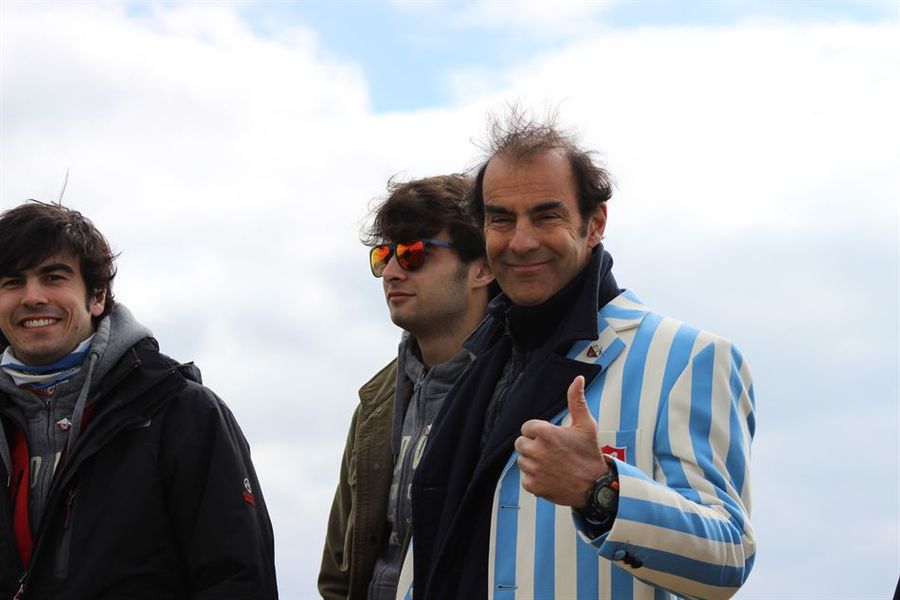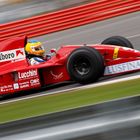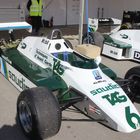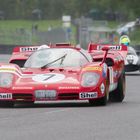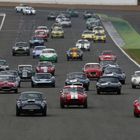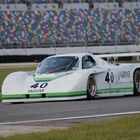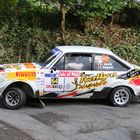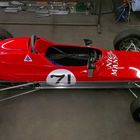Emanuele Pirro Entertains at HMI 2017
- 2 Mar 2017
A highlight of last year’s Historic Motorsport International show was the programme of forums and interviews hosted by Henry Hope-Frost. We managed to capture a goodly chunk of the always entertaining five-times Le Mans winner Emanuele Pirro on the Friday afternoon, and have tried our outmost to present it here as faithfully as we can – engine noise impressions included!
It didn’t take much nudging from Henry to keep Emanuele in full flow, and we apologise to him that we have left out some of his prompting, but he admirably kept the discussion on track leaving the Italian racer to talk about his career. We join him when he is talking about racing at Daytona and Le Mans in 1981, a teenager with just one season of single seaters behind him.
Emanuele Pirro:
“I was just a kid and all my heroes were there. Now drivers at 18 seem much more grown up but back then I was little more than a toddler in a way. They said they would like me at Daytona, then they said ‘just in case you have to do the race we would like you to test the car’. I went to Mugello to do a few laps in the Group 5 Lancia Beta Monte Carlo. I needed to save money and Mugello was about four hours from Rome, I had to be there at eight, so I left home at four in the morning in my little 40hp VW Polo.
“I got there and Beppe Gabbiani, my team-mate, was driving and the car was going past so fast on the long Mugello straight and I got scared! I wasn’t sure I had the guts to stay on the throttle all the way down that straight.
“We got to Daytona and Cesare Fioro told I was going to drive, and I was lucky enough to be in the car that won [the under 2000cc Group 5 class in a Jolly Club Lancia Beta Monte Carlo and fifth overall]. But for me, I was a single-seater driver, I had done go-karts, Formula Abarth and that year I was looking to go do Formula Three, for me racing was get in a car and drive as fast as you could from anywhere from 30-minutes to one hour, and the fastest wins the race.
“The 24-hour race was very different to today, you had to be really careful. The Lancia was a 1.4 litre engine with a big turbo. To cool the turbine down on the straight you had to back off three times. There was no telemetry so I do not know if the others did that but I did!”
[At this point Emanuelle recreates the engine noise of the Lancia on full throttle, then the revs falling away as he lifts, the engine stuttering to pick up due to the lag on the big turbo before hitting max revs again after two or three seconds]
“We really had to look after the car and I did not like that sort of racing. For me, racing was about going fast, not going slow, but then I was a kid, now I look at it in a different way. Now, looking after the car, respecting the car, is an important quality.
“Then we went to Le Mans and again I was with Beppe Gabbiani, just two drivers. I wasn’t fit at all so I don’t know if I was going to be able to finish the race, but when you are young you are stupid and don’t think so much. Beppe started and did the first hour, then I drove the car. My second time down the straight I saw a huge accident, there was debris all over the place, and I admit I was scared.
“I drove round the debris and the next lap I saw an ambulance, was there, and I knew people were injured. I found out later a marshal was killed and I passed the scene many times behind the safety car. When the accident was cleared and we had the green flag, managed one lap at full speed and then there was another big crash, and a driver was killed.
“I couldn’t wait until my stint was finished, I was just an 18-year-old kid and really shocked. So I came in and Beppe Gabbiani gets in the car and I try to relax and get ready, and I was ready for him to finish his stint, I was there with my helmet, waiting…and he didn’t come. You know when the car is due, but we had no television so we didn’t know what was going on, then someone told us that Lancia number 67 had a massive accident on the back straight and the driver was killed…
“This was not true, yes there was an accident but Beppe was unhurt. This was too much, when I started racing I was aware of the danger but the pressure was there and if I someone had offered me a contract to race until the age 30 and I might die I would have signed it, I didn’t care, but I always felt the danger was in your own hands, the more you risk
“But at Le Mans it was a completely different scenario. The accidents happened on the straight, where the driver has no influence, and for me this was a big shock. For the first time I realised that you could get hurt by not doing something wrong.
“I remember Beppe came back to the pits, really shocked, and we looked at each other and said ‘let us go, we don’t want to stay here anymore’ and we drove off in my Polo. I looked back in the mirror at the sign Le Mans as we drove out of town and said ‘never again will I come to this place.’
“I didn’t think about not continuing racing, but for me that kind of racing was finished.
“Many years later I was a different person and the call to go to Le Mans was very welcome. In those days I was doing touring cars – all my career I did touring cars alongside single seaters, touring cars are fun but not so fast, single seaters are fast but maybe not so much fun. In 1992 I finished with single seaters and 92 to 97 I did only touring cars.
“With Audi the cars were state of the art and we won lots, but I started to need some more speed, I started to feel I needed something. When I was called into the office of the big boss of Audi he said ‘this is top secret but we are going to build a car to tackle Le Mans’ I was thinking this is really the right time.
“That started the journey that was beyond expectations. Le Mans is an incredible place, the race is so popular because it involves everybody, it is not only a race for cars and drivers, it is like the spectators, the whole city, takes part. Whatever happens at the end of the race, my opinion is that the popularity of it is down to the race itself, at the end everybody has given all they have, the cars are broken, dirty – you can see they have been worked hard, same for the drivers, spectators, mechanics, journalists.
“At the end of the race everybody had given everything and I think that this is the essence of it, people like to push limits.
“When I went there first time – in fact I did a go-kart World Championship there only three years before my first race, I stole the rental car of my team and drove round the public road as I couldn’t miss the opportunity as I may have never had another chance. When I was on the straight I was thinking that so much history had been written in this place, and history written with fuel, grease, blood of so many people. For me was a special moment.
“Every single time I drove Le Mans I thought that winning and losing is not so much down to the driver – and I don’t believe in luck – if you win it doesn’t mean you are the best driver, you have to be in the right car with the right team mates and to win is a gift. You can win most of the race before the start, the preparation is crucial with all the development of the car.
“In my experience with Audi we were three trios of drivers with our own engineer, mechanics, and all the cars were the same. But with your own mechanics you start preparing the race set up well ahead, trying to have a little edge on your team mates.
“When you do qualifying you split the work, one car is doing set-up work, one testing tyres, and one doing aerodynamic work, and at the end you meet and the best is shared. This is decided by the engineers. The most important work is the set-up. Even if the cars are the same, motorsport is not a perfect science and even if you had two identical cars and has the same set-up they will not necessarily act the same, and sometimes you need a slight imbalance, not 100%, to be happy.
“You want the best set-up for your own car. Tyres are different. If you test the tyres and know the best lap time on each set, how many laps they do, you can share that with the others. So the team that do the set-up work is the privileged one. The aerodynamics are different, a car has personality and they are not quite the same, this is the second best work, working on front and rear downforce.
“If you have an engineer who has the personality to say at a meeting that ‘my car will do the set-up work’ then you have a little bit of an edge. At the start you already have a few tokens in your pocket that can pay off.
“You have people like Bob Wollek who was an incredible driver but never won the race. I am not five times better than Bob Wollek but so many things can let you lose the race easily.
“In 2005 I was disappointed, we were really good, it was the first time I had taken the start, I got in the lead and the car was really fast. I had an advantage and then the engineer asked if I wanted to do a double stint as the car was going so good. I think a double stint at the beginning is too much but when they ask you cannot say no.
“In fact that was four stints as each is a double and I did nearly four hours, it was going so well, then there was a safety car just before I was stopping and I lost concentration. This was a mistake and a big lesson. At the restart I was at Arnage, I hadn’t warmed the tyres enough and went straight on and broke the nose.
“I went back and changed the nose and we lost 30-seconds, not much, but then Alan McNish who was my team-mate tried to catch up and was push, push push – and crashed heavily at the Porsche Curves and we lost lots of time. Tom Kristensen won the race but I think it was my mistake, and Alan’s mistake – you have to do your job, nothing more.”
Host Henry Hope-Frost then asked Emanuele how he got into historic racing:
“I had a sponsor who had some Ferraris – this was 1995 so I still had a long way to go - and he asked me if I wanted to do the Mille Miglia in his Ferrari. Not that I was arrogant but I said ok but didn’t really feel it as a great opportunity.
“But I drove this old car and it was so nice, the Mille Miglia was so nice, and I met somebody who was generous and invited me to do some other races – he owned a Ferrari 512M, which was the car driven by Ignazio Giunti who was my childhood hero. I got so passionate about this, I tried to respect the cars quite a bit, maybe more than the average professional drivers, I got invited more.
“At the Mille Miglia I met Lord March, shook his hand, and Goodwood had just started. I said if there was a chance I would like to come and he invited me. That started a really good friendship and since then I have been a million times to Goodwood, and I have been lucky enough to sit in cars I could never have even dreamed about.”
A discussion then started on age, Henry commenting that he was 14 when Emanuele was winning in Formula 3000.
“I still have all my trophies and helmets, and in my karting days lost of them ae for the youngest driver, and now I am almost the oldest. Though last night I was the youngest of the oldest as we had a dinner with Jacky Ickx, Derek Bell, Jacky Oliver, Jurgen Barth and …ah! Dario Franchitti was there who is younger than me.”
Questions from the floor (the actual questions are abridged): How do you adapt so successfully from car to car in historic racing?
“In my career it happened that I was driving many different cars in one season because of opportunities, and I hate to refuse an opportunity! In my first year of Formula One – 1989- I did Japanese Formula 3000, I was a works driver for BMW, I was a test driver for McLaren, I took 108 flights in 1989.
“For BMW, as I was living in Japan, and the McLaren test programme was every second week, Tuesday, Wednesday and Thursday in Suzuka, I would fly on the Friday to Europe, sometime get to the track on Saturday as there were no direct flights and go straight into qualifying. Then fly back to Tokyo.
“I think this gave me a versatility and a way to adapt, but to be realistic I would have liked to have had more experience but I learnt to immediately find confidence in the car. I remember in my first Formula One test in 1985 with a Benetton-BMW in Donington, there was a bunch of drivers, Andy Wallace, myself, a couple more, we all had 16-laps. In those 16-laps you had to deliver and at the end of the day every car is just a car, you brake, you turn, in they are fundamentally the same but the amount of downforce and the amount of power so was so high that you just had to believe.
“Normally you try to learn by going a little bit faster, a little bit faster…but this would have taken 100 laps. So I decided it had to work, and it did and I was asked back by Benetton three years later.”
From the floor - why do you think historic racing is popular?
“In a historic race car the driver is much more important than in a modern car. In a modern high-downforce car if you are half a second off the pace that is no good, because the limit is so black and white. If you are one second off the pace the car is not sliding, it feels like cruising. In a historic car there is white, then light grey, mid grey, dark grey…and darker and darker before you get to black.
“You can drive well without going 100% as the limit as it is so vague. Driving well means braking at the right spot, using the brakes to their maximum, you decide – sometimes you have to be gentle with the braking system – you have to double declutch and release the clutch to get the car in a good attitude, being on the right line and applying the throttle nicely so you don’t power slide too much.
“Once you make the corner and it came out the way you want it – this is what I like. If I was there trying to shape my future career I would be more aggressive.
“I was talking to the guys from Cosworth just now as when I was driving for Benetton there was a very mean orange light which came on every time you over-reved even slightly, and the light stayed on. If you did a small over-rev and stopped in the pits, they had to change the engine. Even if you had one more run on qualifying tyres to go the engine people would say no, let’s call it a day because the light was on.
“Over-revving…sometimes when you downshift you want to engine brake as much as possible [more engine noises as Emanuelle simulates downshifting on the brakes…] and you want the engine to go exactly close to the revs and not over. When I was a test driver for McLaren I was racing for Scuderia Italia in 1991, and we were at Estoril for the Grand Prix and the next race was going to be Suzuka.
“Senna was fighting for the championship with Prost in the Ferrari so Honda came up with a super engine – a V12 – and needed to do a long run to verify the durability for the next race. Senna was amazing into a corner and braking, Prost would go from sixth to the gear to he needed, Senna would so down through every gear, hitting the revs just right, no over-rev.” [More engine noises, Emanuele showing how a race engine sounds being slammed down through the gearbox from sixth to second at high revs….you had to be there!]
Any transcription of spoken dialogue is by its nature an interpretation, no one talks in sentences, but we have tried to give the feel of Emanuele and his love of our sport and delight in recounting his adventures!


